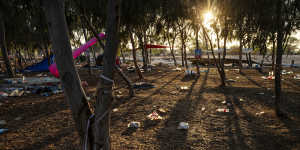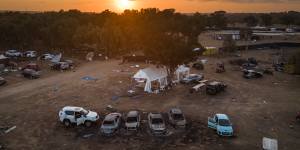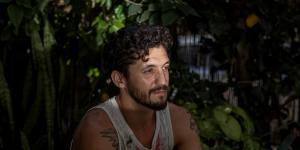Some 4000 revellers gathered on the night of October 6 at a field in southern Israel,mere kilometres from the Gaza Strip border,for the Tribe of Nova music festival. At dawn,thousands of Hamas-led terrorists stormed Israel’s defences under the cover of a rocket barrage.

Scattered belongings at the Tribe of Nova festival,10 days after it was attacked by Hamas-led terrorists.Tamir Kalifa/The New York Times
About 1200 people were killed that day,the deadliest in Israeli history according to Israeli authorities,including 360 at the rave alone. Many of the ravers were under the influence of mind-altering substances such as LSD,MDMA and ketamine as they witnessed the carnage or fled for their lives.
For a group of Israeli researchers at the University of Haifa,the attack has created a rare opportunity to study the intersection of trauma and psychedelics,a field that has drawn increased interest from scientists in recent years.
The survivors of the Nova festival present a case study that would be impossible to replicate in a lab:a large group of people who endured trauma while under the influence of substances that render the brain more receptive and malleable.
Illegal in most countries,including Israel,these substances are now on the cusp of entering the psychiatric mainstream. Recent research suggests that careful doses of drugs such as MDMA and psilocybin,the active ingredient in “magic mushrooms”,might be useful in treating post-traumatic stress disorder.
The festival participants were under the influence during their trauma,not in a controlled clinical setting,but researchers say studying them could help scientists better understand how psychedelics might be used to treat patients after a traumatic event.
The researchers surveyed more than 650 Nova survivors. Roughly 23 per cent said they took hallucinogens such as LSD,also known as acid,and about 27 per cent used MDMA,a stimulant and psychedelic commonly called molly or ecstasy. Many attendees used more than one substance.
Participants in the survey described a variety of experiences while using drugs on October 7,ranging from hallucinations to extreme clarity,from panic to resolve and from paralysis to action.
“Even though people were dropping on the ground screaming next to me,I felt a growing sense of confidence,that I was invincible,” said Yarin Reichenthal,26,a judo coach who experienced the attack while on LSD. “I felt enlightened. I felt no fear at all.”
In many instances,according to preliminary results of the researchers’ survey,even festivalgoers using the same drugs experienced the attack in different ways – variances that might have meant the difference between life and death.

An aerial view of the Tribe of Nova festival site four days after it was attacked by Hamas-led terroristsNYT
The scientists cautioned that the study was not a comprehensive review of how every participant at the rave fared because so many were killed.
“We only hear the stories of those who made it out alive,” said Roy Salomon,a cognitive science professor at the University of Haifa and a co-author of the study. “So our understanding is influenced by survivors’ bias.”
Witnesses said that for many attendees,drug use appeared to hamper their ability to flee for safety. Some ravers were too zoned out on psychedelics to realise what was happening and escape. The researchers said that those experiences were also important to their findings.
“There are two main questions,” said Roee Admon,a University of Haifa psychology professor and a co-author of the study. “How is the traumatic event experienced under different psychedelics,and what might the long-term clinical impact be?”
Admon and Salomon,who are leading the survey,are studying the survivors in the hopes of gleaning information about how drug use affected their experience of trauma. They are also studying how the attendees appear to be recovering and coping. A graduate student,Ophir Netzer,also helped write the study.
Of those who made it out alive,some survivors appeared to be recovering well and others reported feeling numb and detached. Some said they had increased their drug use since the attack to cope.
“We were all in such a heightened emotional state,which made us all the more vulnerable when the attack began,” said Tal Avneri,18,who said he stayed relatively lucid on October 7 after taking MDMA. “And when you’re hurt at your most fragile,you can later become numb.”
For devotees of Israel’s trance scene,a festival like Nova is more than just a way to let loose. Many view the raves — often held in forests and deserts,with pounding electronic beats and mind-altering substances — as spiritual journeys amid a like-minded community.
“The love I felt on the dance floor,the raves,the psychedelics — they helped me cope with my mother’s death,” said Yuval Tapuhi,27,a Nova survivor from Tel Aviv,Israel.

Tal Avneri was under the influence of MDMA when Hamas attacked the Tribe of Nova festival.Avishag Shaar-Yashuv/The New York Times
Around 6.30am on October 7,as the sky turned pink,and many revellers were beginning the most intense part of their trips,rockets from Gaza suddenly streaked through the sky. Air-raid sirens and loud explosions cut through the music.
Some people fell to the ground and burst out crying,multiple survivors said. Some attendees scrambled to evade the terrorists by hiding in bushes,behind trees or in riverbeds. Others sprinted through open fields,running for hours before reaching safety.
Still others fled in their cars,creating a huge traffic jam at the rave’s main exit,where they became easy targets for Palestinian attackers swarming across the border.
Amid the gunfire and rocket barrage,Reichenthal,the judo coach,had what he describes as a transcendent experience,which he credits with his survival. The LSD trip,he said,made it feel as if his fear had been stripped away,and he murmured Bible verses as he ran to safety.
Many survivors described their initial panic being replaced with a cool-headed resolve – a function,one expert said,of stress counteracting the effects of the drugs.

Yuval Tapuhi used psychedelics to cope with her mother’s death.Avishag Shaar-Yashuv/The New York Times
Sebastian Podzamczer,28,attributed his survival,at least in part,to a huge rush of energy and clarity he experienced while using MDMA. The drug’s influence,he said,gave him what he believes was the strength to carry his girlfriend,who had been paralysed by fear.
Podzamczer,a former combat medic in the Israeli military,had PTSD after his service. Taking psychedelics recreationally,he said,helped him unravel some of that pain,allowing him to speak about his military service without shaking and panicking.
“But I always thought that if I was caught in an extreme situation like that,I’d be paralysed by panic from my PTSD,” Podzamczer said. Instead,he found that the MDMA he took at the rave “helped me stay afloat,to act more quickly and decisively”.

Sebastian Podzamczer found MDMA helped him during the attack.Avishag Shaar-Yashuv/The New York Times
High levels of stress can almost “overwhelm” the effects of a drug and jolt people back to reality,said Rick Doblin,the founder of the Multidisciplinary Association for Psychedelic Studies,a nonprofit organisation in California that finances scientific research but is not involved in the Nova survivor study.
Almog Arad,28,said that her acid trip kicked in after the attack began but that the circumstances quickly “minimised” the drug’s effects. While she continued to see intense colours and patterns as she fled,her decision-making remained relatively sound,she said.
“Adrenaline was the strongest drug I took that day,” she said.
The University of Haifa researchers plan to follow the survivors for years,tracking their neural activity with functional magnetic resonance imaging,or fMRI.
They have presented their preliminary findings in a preprint paper,a scientific manuscript undergoing peer review.
Compared with survivors who used other substances,attendees who used MDMA are recovering better and showing less severe symptoms of PTSD,according to the study’s preliminary conclusions.
Many MDMA users in particular,the researchers said,believe that using the drug helped them survive. That perception,the scientists added,could have influenced their ability to cope with their trauma.
“The way in which we remember the trauma has a great impact on how we process it,” Admon said. “So even if a victim’s perception is subjective,it will still have a great impact on their recovery.”
The researchers said it was difficult to assess the exact doses that the festivalgoers used,making it hard to analyze how different quantities of drugs affected people.
Reichental said he witnessed one man at the rave who appeared to be so out of it that as gunfire sounded and another raver tried to help him escape,the man instead began to flirt with her. “How lucky it is that destiny brought us together,” Reichenthal recalled the man saying. He does not believe the man survived the attack.
Psychologists and survivors said those ravers who took ketamine,a psychedelic with an intense tranquillising and dissociative effect,appeared to be one of the groups hit hardest.
Immediately after the Nova massacre,a group of therapists and experts established a volunteer relief network for survivors,known as Safe Heart,that provided psychological support for more than 2200 people. The group has collaborated with the University of Haifa researchers as well as with a separate study at Bar-Ilan University.
“Most people who undergo a traumatic experience do not develop PTSD,” Admon said. “Identifying those who do and treating them as early as possible is critical to their healing.”
This article originally appeared in.
Get a note directly from our foreigncorrespondentson what’s making headlines around the world..